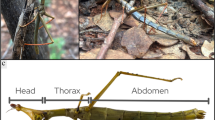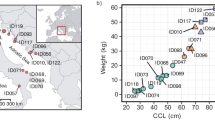Abstract
The anatomical characteristics of glands of the gut of the African pied crow (Corvus albus) were investigated using histological and histochemical techniques. Seven crows were used for this study. The result showed that the glands were distributed throughout all the segments of the gut of the African pied crow. In the oropharynx, tongue, and esophagus, glands were present in the subepithelial regions and in the lamina propria mucosae, while glands of the proventriculus and ventriculus were observed in the lamina propria mucosae and in the submucosa. Glands of the proventriculus showed both serous and mucous characteristics and the crypt glands of the crow’s small intestine extended deep through the thickness of the submucosa and contained epithelia which varied from simple columnar epithelium near the villi to the pseudostratified columnar epithelium deep into the submucosa. Although goblet cells which lined the lumen of the small and large intestines demonstrated PAS-positive reactions, cells of the crypts had characteristic features of serous-secreting cells. In conclusion, the data presented in this study represent morphofunctional modifications of the gut of the crow that may be related to their feeding habit, exposure to microorganisms, and species adaptations which could guide the management of this wild species.






Similar content being viewed by others
References
Aitken RNC (1958) A histochemical study of the stomach and intestine of the chicken. J Anat 92(3):453
Arai N, Hashimoto Y, Kitagawa H, Kon Y, Kudo N (1988) Immuno-histochemical study on the distribution of lymphoid tissues in the upper alimentary and respiratory tracts of chickens. JPN J Vet Sci 50(1):183–192
Bacha WJ, Bacha LM (2000) Color atlas of veterinary histology, 2nd edn. Lippincott Williams & Wilkins, Philadelphia
Bansil R, Turner BS (2006) Mucin structure, aggregation, physiological functions and biomedical applications. Curr Opin Colloid Interface Sci 11:164–170
Bar-Shira E, Cohen I, Elad O, Friedman A (2014) Role of goblet cells and mucin layer in protecting maternal IgA in precocious birds. Dev Comp Immunol 44:186–194
Batah AL, Selman HA, Saddam M (2012) Histological study for stomach (proventriculus and gizzard) of coot bird Fulica atra. Diyala Agric Sci J 4(1):9–16
Bezuidenhout AJ, Van Aswegen G (1990) A light microscopic and immune-cytochemical study of the gastro-intestinal tract of the ostrich (Struthiocamelus L.). Onderstepoort J Vet Res 57:37–48
Burks W, Laubach S, Jones SM (2008) Oral tolerance, food allergy, and immunotherapy: implications for future treatment. J Allergy Clin Immunol 121(6):1344–1350
Crole MR, Soley JT (2010) Surface morphology of the emu (Dromaius novaehollandiae) tongue. Anat Histol Embryol 39(4):355–365
Del Hoyo J, Elliot A, Christie D (2009) Handbook of the birds of the world. Lynx Edicions, Barcelona
Gardner LL (1927) On the tongue in birds. Ibis 69(s1):185–196
Gargiulo AM, Lorvik S, Ceccarelli P, Pedini V (1991) Histological and histochemical studies on the chicken lingual glands. Br Poult Sci 32(4):693–702
Gargiulo AM, Lorvik S, Ceccarelli P, Pedini V (2007) Histological and histochemical studies on the chicken lingual glands. Bri Poult Sci 32(4):693–702
Guimaraes JP, Mari RDB, Carvalho HSD, Watanabe IS (2009) Fine structure of the dorsal surface of ostrich’s (Struthiocamelus) tongue. Zool Sci 26(2):153–156
Hassan SA, Moussa EA (2012) Gross and microscopic studies on the stomach of domestic duck (Anas platyrhynchos) and domestic pigeon (Columba livia domestica). J Vet Anat 5:105–127
Hollingsworth MA, Swanson BJ (2004) Mucins in cancer: protection and control of the cell surface. Nat Rev Cancer 4:45–60
Igwebuike UM, Anagor TA (2013) Gross and histomorphological assessment of the oropharynx and tongue of the guinea fowl (Numidameleagris). Anim Res Int 10(2):1739–1746
Jackowiak H, Godynicki S (2005) Light and scanning electron microscopic study of the tongue in the white tailed eagle (Haliaeetusalbicilla, Accipitridae, Aves). Ann Anat 187(3):251–259
Jackowiak H, Skieresz-Szewczyk K, Godynicki S, Iwasaki SI, Meyer W (2011) Functional morphology of the tongue in the domestic goose (Anser anser f. domestica). Anat Record 294(9):1574–1584
Kadhim KK, Zuki ABZ, Noordin MM, Babjee SMA (2011) Histomorphology of the stomach, proventriculus and ventriculus of the red jungle fowl. Anat Histol Embryol 40:226–233
Moniaux N, Escande F, Porchet N, Aubert JP, Batra SK (2001) Structural organization and classification of the human mucin genes. Front Bio Sci 6:D1192–D1206
Oliveira D, Colaço Filho MAC, Santos JF, Oliveira D, Barbosa AMS (2008) Anatomic description of the proventriculus and gizzard of an ostrich (Struthio camelus). Braz J Morphol Sci 25(1–4):1–34
Pierce AE, Long PL (1965) Studies on acquired immunity to coccidiosis in bursaless and thymectomized fowls. Immunology 9(5):427
Pomeroy DE (1975) Birds as scavengers of refuse in Uganda. Ibis 117(1):69–81
Rana J, Dhote BS, Ambwani TK, Patel SK (2016) Histochemical studies on small intestine of uttara fowl. IJSET 5(3):1181–1188
Senthamil Selvan P, Ushakumary S, Ramesh G (2008) Studies on the histochemistry of the proventriculus and gizzard of post-hatch guinea fowl (Numida meleagris). Int J Poult Sci 7(11):1112–1116
Sheehan DC, Hrapchak BB (1980) Theory and practice of histotechnology, 149
Shiina T, Shimizu Y, Izumi N, Suzuki Y, Asano M, Atoji Y, Nikami H, Takewaki T (2005) A comparative histological study on the distribution of striated and smooth muscles and glands in the esophagus of wild birds and mammals. J Vet Med Sci 67(1):115–117
Strobel S, Mowat AM (1998) Immune responses to dietary antigens: oral tolerance. Immunol Today 19(4):173–181
Suganuma T, Katsuyama T, Tsukahara M, Tatematsu M, Sakakura Y, Murata F (1981) Comparative histochemical study of alimentary tracts with special reference to the mucous neck cells of the stomach. Am J Anat 161(2):219–238
Tucker AS, Miletich I (eds) (2010) Salivary glands. Development, adaptations and disease. Front Oral Biol Basel 14:1–20
Udoumoh AF, Igwebuike UM, Ugwuoke WI (2016) Morphological features of the distal ileum and ceca of the common pigeon (Columba livia). J Exp Clin Anat 15(1):27–30
Uni Z, Smirnov A, Sklan D (2003) Pre- and post hatch development of goblet cells in the broiler small intestine: effect of delayed access to feed. Poult Sci 82:320–327
Wesley A, Mantle M, Man D, Qureshil R, Forstner G, Forstner J (1985) Neutral and acidic species of human intestinal mucin: evidence for different core peptides. J Biol Chem 260(13):7955–7959
Zhu L (2015a) Histological and histochemical study on the stomach (proventriculus and gizzard) of black-tailed crake (Porzana bicolor). Pakistan J Zool 47(3):607–616
Zhu L (2015b) Histological study of the oesophagus and stomach in grey-backed shrike (Lanius tephronotus). Int J Morphol 33(2):459–464
Author information
Authors and Affiliations
Corresponding author
Ethics declarations
The guidelines for the care and use of the animals were strictly followed in accordance with the Ethics and Regulations guiding the use of research animals as approved by the University of Nigeria, Nsukka.
Experimental animals
Seven adult African pied crows (C. albus) weighing between 458 and 601 g were used for this study. They were obtained from the Department of Zoology and Environmental Biology garden of the University of Nigeria Nsukka and were taken to the Department of Veterinary Anatomy, Faculty of Veterinary Medicine, University of Nigeria for commencement of the study. The birds were sacrificed following intramuscular injection of ketamine (1 ml/100 g body weight of bird).
Conflicts of interest
The authors declare that they have no conflict of interest.
Rights and permissions
About this article
Cite this article
Udoumoh, A.F., Ikejiobi, J.C. Morphological features of glands in the gastrointestinal tract of the African pied crow (Corvus albus). Comp Clin Pathol 26, 585–590 (2017). https://doi.org/10.1007/s00580-017-2425-3
Received:
Accepted:
Published:
Issue Date:
DOI: https://doi.org/10.1007/s00580-017-2425-3




